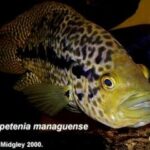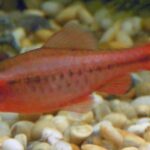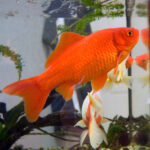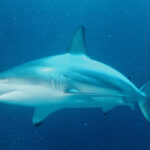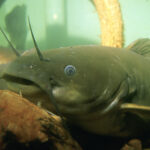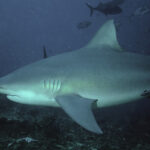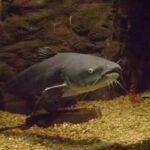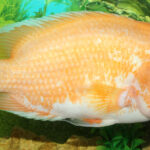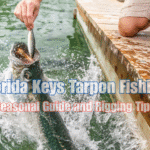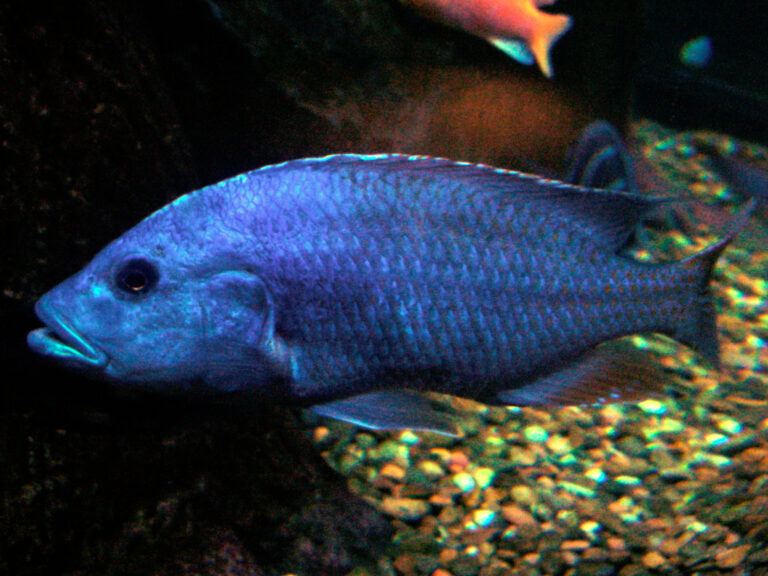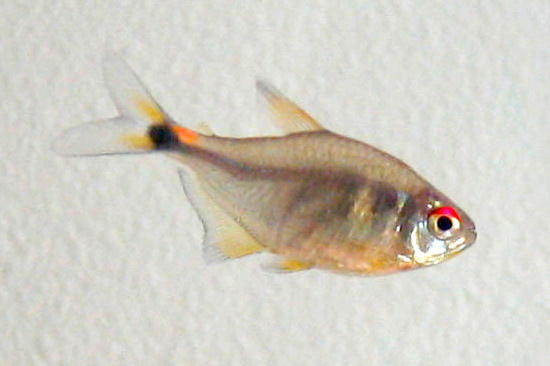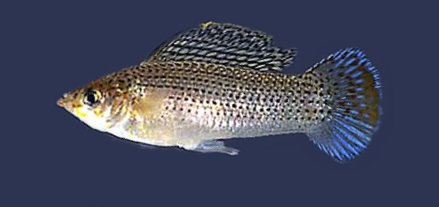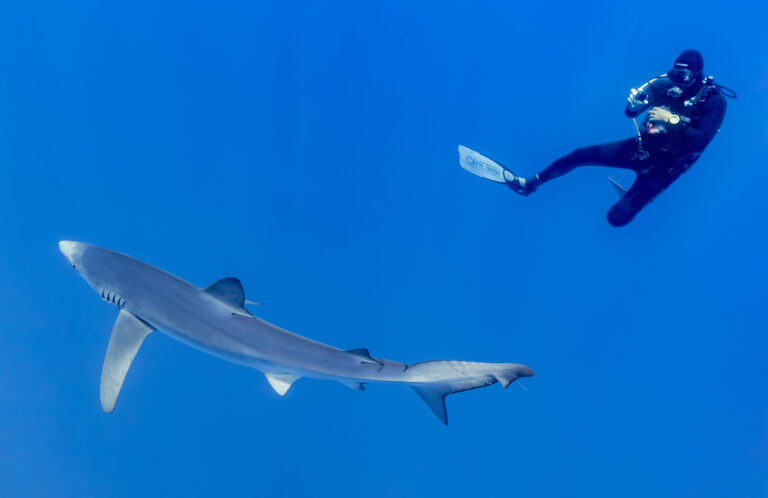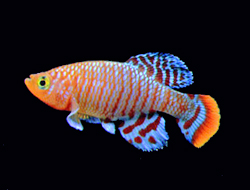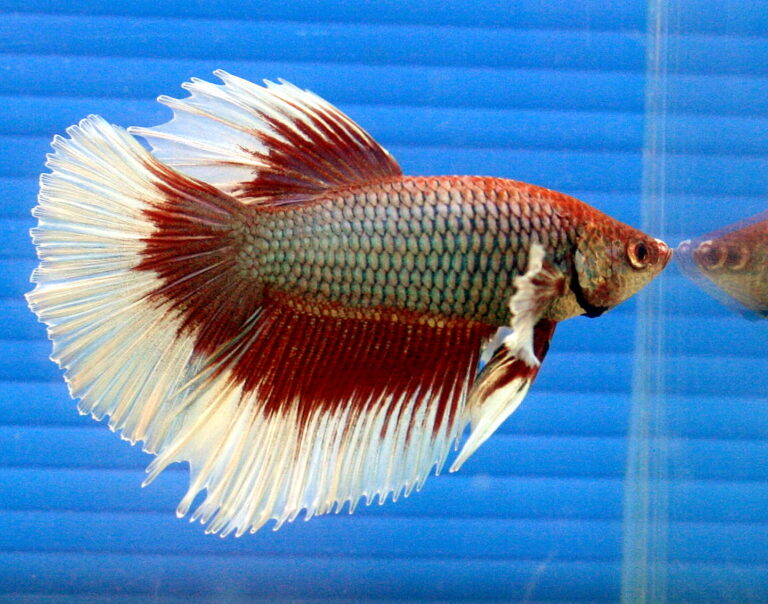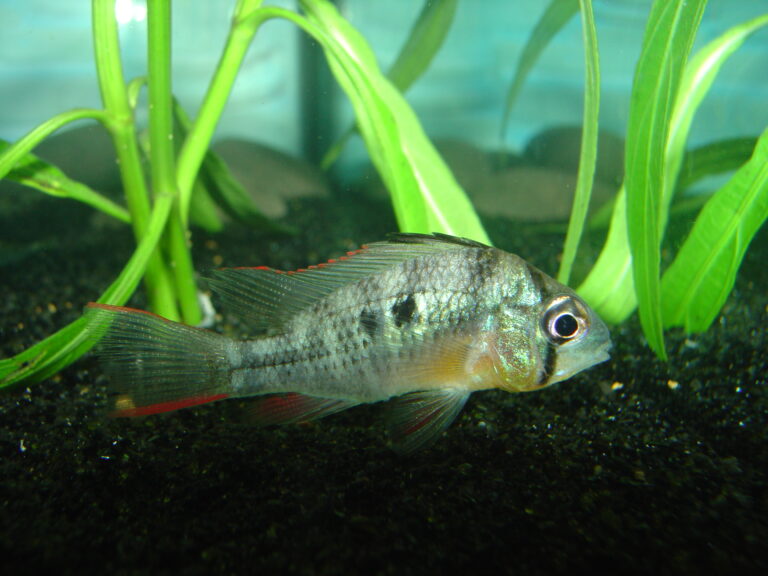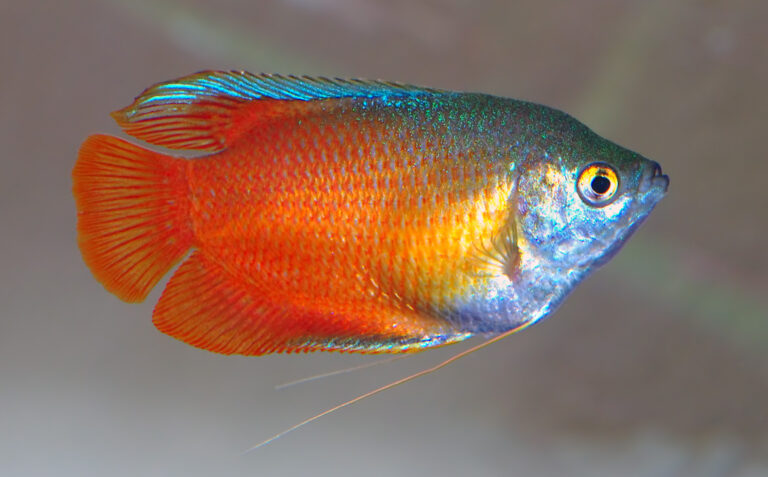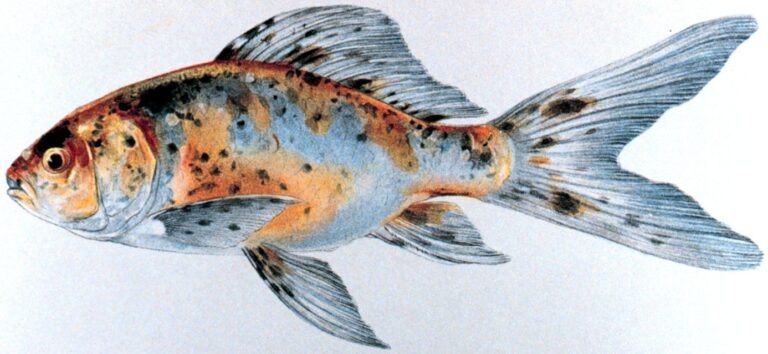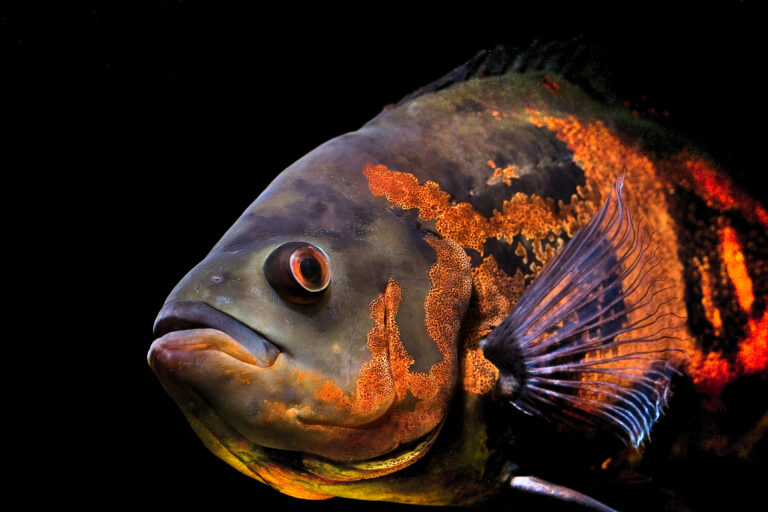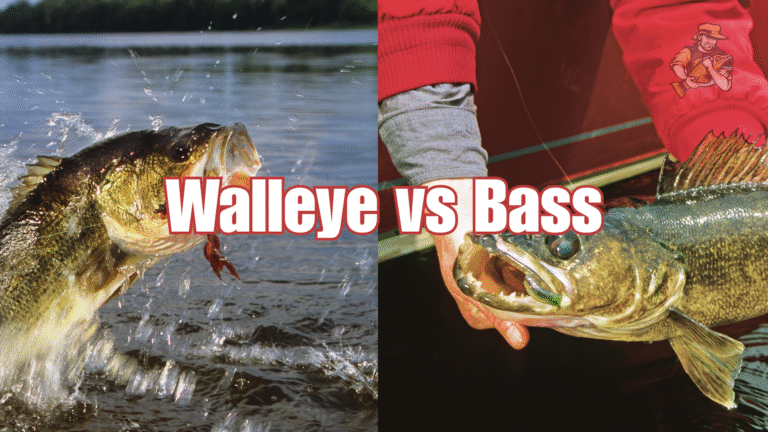Flame Tetra
By Ryan Maron | Last Modified: June 7, 2025

The Flame Tetra (Hyphessobrycon flammeus) stands as one of the most recognizable and beloved freshwater aquarium species in the characin family. This vibrant South American fish captivates aquarists worldwide with its brilliant red-orange coloration and peaceful schooling behavior. Originally discovered in the coastal river systems of southeastern Brazil, the Flame Tetra has become a cornerstone species in the global aquarium trade, serving both as an entry-level fish for beginners and a prized specimen for advanced hobbyists seeking to create stunning biotope displays.
Beyond its ornamental value, the Flame Tetra plays a crucial ecological role as a mid-water foraging species in its native habitat. These fish contribute significantly to nutrient cycling within their ecosystem by consuming various microorganisms, small invertebrates, and organic detritus. Their schooling behavior creates important predator-prey dynamics that support the overall health of South American river communities. Understanding the biology and natural history of Hyphessobrycon flammeus provides valuable insights into tropical freshwater ecosystem functioning and informs conservation efforts for similar characin species throughout the region.
| Feature | Details |
|---|---|
| Common Name | Flame Tetra |
| Scientific Name | Hyphessobrycon flammeus |
| Family | Characidae |
| Typical Size | 4-5 cm (1.5-2 inches), 2-4 grams |
| Habitat | Slow-moving coastal rivers and streams |
| Diet | Omnivorous – small invertebrates and plant matter |
| Distribution | Southeastern Brazil coastal basins |
| Conservation Status | Least Concern |
Taxonomy & Classification
The Flame Tetra belongs to the order Characiformes, family Characidae, and genus Hyphessobrycon, one of the most species-rich genera within the characin group. First described by Myers in 1924, Hyphessobrycon flammeus represents a classic example of Neotropical freshwater fish diversity. The genus Hyphessobrycon currently contains over 140 recognized species, making it one of the largest genera within the Characidae family.
The taxonomic classification of the Flame Tetra follows a well-established hierarchy that reflects its evolutionary relationships within South American characins. Kingdom Animalia encompasses all animal life, while Phylum Chordata includes all vertebrates possessing a notochord. Class Actinopterygii represents the ray-finned fishes, the most diverse group of vertebrates on Earth. Order Characiformes specifically contains the characins, a predominantly freshwater group found throughout South America and Africa.
Recent molecular phylogenetic studies have confirmed the monophyletic nature of the Hyphessobrycon genus, though some species previously assigned to this group have been reclassified. The Flame Tetra’s position within the genus remains stable, with genetic analysis supporting its distinct species status. Morphological characteristics, including fin ray counts, lateral line scale numbers, and tooth structure, provide additional taxonomic markers that distinguish H. flammeus from closely related species.
Several synonyms exist for Hyphessobrycon flammeus in older literature, including Hemigrammus flammeus and Tetragonopterus flammeus. These historical names reflect early classification attempts before modern systematic methods established the current nomenclature. The species epithet “flammeus” derives from Latin, meaning “flame-colored,” directly referencing the fish’s distinctive red-orange coloration that defines its common name.
Physical Description
The Flame Tetra exhibits a compact, laterally compressed body typical of small characins, with adults reaching 4-5 centimeters in total length. The species displays pronounced sexual dimorphism, with males generally appearing more slender and vibrant than females. Body depth typically measures 35-40% of standard length, creating the characteristic diamond-shaped profile when viewed from the side.
Coloration represents the most striking feature of Hyphessobrycon flammeus, with healthy specimens displaying brilliant red-orange hues across the posterior two-thirds of the body. The anterior portion maintains a more subdued silver-gold base color, creating a gradual transition that intensifies toward the caudal region. This flame-like color pattern becomes particularly pronounced during breeding conditions or when fish experience heightened emotional states.
The dorsal fin typically contains 10-11 rays, with the leading edge often displaying a distinctive black marking followed by white and red coloration. Anal fin rays number 18-22, extending along a significant portion of the ventral body profile. Both the dorsal and anal fins may show red pigmentation, particularly in mature males during spawning periods. The caudal fin appears deeply forked with red coloration throughout, while pectoral and pelvic fins remain largely transparent with subtle red tinges.
Scale counts provide important diagnostic features, with lateral line scales numbering 28-32, typically 30. The lateral line itself remains incomplete, extending only partway along the body length. Predorsal scales count 9-11, while circumpeduncular scales number 14-16. These meristic characteristics prove essential for accurate species identification and distinction from similar Hyphessobrycon species.
Eye diameter measures approximately 30-35% of head length, proportionally large as befits a visual predator in often turbid water conditions. The mouth appears terminal with small, pointed teeth adapted for capturing small prey items. Gill rakers number 8-10 on the lower limb, reflecting the species’ planktivorous feeding strategy in natural environments.
Habitat & Distribution
The Flame Tetra inhabits the coastal river basins of southeastern Brazil, with its natural range encompassing the states of Rio de Janeiro, São Paulo, and southern Minas Gerais. Primary distribution centers around the Paraíba do Sul River basin, Guandu River system, and various smaller coastal drainages that flow directly into the Atlantic Ocean. This relatively restricted range classifies the species as endemic to the Brazilian Atlantic Forest region.
Natural habitats consist primarily of slow-moving rivers and streams with soft, acidic water conditions. Water temperature in these systems typically ranges from 20-26°C (68-79°F), with pH values between 5.5-7.0 and very low mineral content. Dissolved oxygen levels remain moderate to high due to the flowing nature of these waterways and abundant riparian vegetation that provides continuous organic input.
Substrate composition varies from sandy bottoms in wider river sections to rocky areas with accumulated leaf litter in forested reaches. Dense aquatic vegetation, including species of Echinodorus, Cabomba, and various moss species, creates complex habitat structure that provides both shelter and foraging opportunities. Overhanging terrestrial vegetation contributes significant amounts of allochthonous organic matter that supports the base of the food web.
Seasonal variations significantly impact habitat conditions, with wet season flooding expanding available habitat while dry season concentration increases population densities in remaining pools. Water levels can fluctuate dramatically between seasons, requiring Flame Tetras to demonstrate considerable adaptability in habitat utilization. Temperature variations remain relatively modest due to the tropical climate, though dry season temperatures may reach slightly higher peaks.
Human activities have substantially modified much of the Flame Tetra’s native range through urbanization, agricultural development, and industrial activities. The Paraíba do Sul basin, in particular, faces significant pollution pressure from metropolitan areas including Rio de Janeiro and São Paulo. Habitat fragmentation through dam construction has further isolated populations and reduced genetic connectivity between river systems.
Diet & Feeding Behavior
Flame Tetras exhibit omnivorous feeding behavior with a pronounced preference for small invertebrates, zooplankton, and organic detritus. In natural environments, their diet consists primarily of chironomid larvae, small crustaceans, rotifers, and various microorganisms found within the water column and among aquatic vegetation. Stomach content analyses reveal that animal protein comprises approximately 60-70% of their natural diet, with plant material and detritus accounting for the remainder.
Feeding activity peaks during dawn and dusk periods when light conditions favor their visual hunting strategies while providing protection from larger predators. The species employs a combination of active hunting and opportunistic foraging, rapidly darting through the water column to capture suspended prey items. Their relatively large eyes and terminal mouth position optimize them for detecting and capturing small, mobile prey in the mid-water region.
Seasonal dietary shifts occur in response to prey availability and environmental conditions. During wet seasons, increased terrestrial input provides abundant fallen insects and organic matter, while dry seasons necessitate greater reliance on aquatic invertebrates and algal growth. Juvenile Flame Tetras focus primarily on smaller prey items including nauplii, small rotifers, and protozoa, gradually incorporating larger prey as they mature.
Schooling behavior significantly influences feeding efficiency, with groups of Flame Tetras coordinating their foraging activities to maximize prey capture success. This cooperative behavior allows them to exploit patchy food resources more effectively than solitary individuals. When one fish detects a concentration of prey, others quickly converge on the area, creating feeding aggregations that can persist for several minutes.
The species demonstrates remarkable dietary flexibility in aquarium environments, readily accepting commercial flake foods, frozen preparations, and live foods. This adaptability has contributed significantly to their success in the aquarium trade and ease of captive breeding. Optimal aquarium nutrition requires a varied diet that mimics the protein-rich nature of their wild feeding habits, with regular offerings of small live or frozen invertebrates supplementing prepared foods.
Behavior & Adaptations
Schooling behavior represents the most prominent behavioral characteristic of Flame Tetras, with groups typically consisting of 10-50 individuals in natural environments. This gregarious nature serves multiple adaptive functions including predator detection, foraging efficiency, and reproductive synchronization. School structure remains relatively loose during feeding periods but tightens considerably when predators approach or during periods of stress.
Within schools, Flame Tetras exhibit complex social hierarchies based on size, age, and reproductive condition. Dominant individuals, typically larger males, maintain preferred positions within the school and demonstrate priority access to prime feeding locations. Subordinate fish adjust their positioning and behavior accordingly, creating dynamic social structures that shift based on environmental conditions and individual status changes.
Territorial behavior emerges primarily during breeding periods when males establish and defend small spawning territories. These territories typically encompass areas of dense vegetation or favorable substrate conditions where females can deposit eggs. Territorial displays include fin spreading, color intensification, and aggressive chasing of intruding males. Outside breeding seasons, territorial behavior remains minimal, with the species maintaining its peaceful schooling nature.
Predator avoidance strategies include rapid escape responses, coordinated schooling movements, and utilization of complex habitat structures for shelter. When threatened, schools of Flame Tetras can execute synchronized directional changes within milliseconds, creating confusion effects that reduce individual predation risk. Their compact body shape and agile swimming ability allow them to navigate through dense vegetation where larger predators cannot follow.
Diel activity patterns show peaks during crepuscular periods, with reduced activity during midday hours and minimal movement at night. This behavioral rhythm corresponds with optimal feeding opportunities and predator avoidance strategies. During daylight hours, schools often seek shelter among aquatic vegetation or near submerged structures, emerging to forage in open water as light levels decrease.
Communication within schools occurs through visual cues, lateral line detection of water movements, and possibly chemical signals. Color changes serve as important visual communication tools, with stressed or excited fish displaying more intense coloration patterns. These behavioral adaptations reflect millions of years of evolution in complex freshwater ecosystems where survival depends on effective group coordination and environmental awareness.
Reproduction & Life Cycle
Flame Tetras reach sexual maturity at approximately 6-8 months of age when they attain lengths of 3-4 centimeters. Sexual dimorphism becomes pronounced in mature individuals, with males displaying more intense coloration, slender body profiles, and slightly extended fin rays. Females appear more robust with rounder abdomens, particularly when gravid with developing eggs.
Spawning occurs seasonally in natural environments, typically coinciding with the onset of rainy seasons when water levels rise and food availability increases. Higher water temperatures and increased photoperiod trigger reproductive behavior, with peak spawning activity occurring between September and February in their native range. Multiple spawning events may occur throughout the reproductive season, allowing populations to take advantage of favorable environmental conditions.
Courtship behavior involves elaborate displays by mature males who establish temporary territories in areas of dense vegetation or favorable substrate. Males intensify their coloration and perform swimming displays to attract females, including rapid circular movements and fin spreading behaviors. Successful courtship culminates in spawning events where pairs release gametes simultaneously over suitable substrate or vegetation.
Fecundity varies with female size and condition, with mature females capable of producing 100-300 eggs per spawning event. Eggs appear transparent to slightly amber-colored, measuring approximately 0.8-1.0 millimeters in diameter. The adhesive nature of the eggs allows them to attach to plant material or substrate, providing protection during the vulnerable embryonic development period.
Embryonic development proceeds rapidly in warm water conditions, with hatching occurring 24-36 hours after fertilization at temperatures of 24-26°C. Newly hatched larvae possess yolk sacs that sustain them for the first 3-4 days before they begin actively feeding on microscopic organisms. Larval development progresses through several distinct stages before juveniles achieve the characteristic adult body form and coloration.
Parental care remains absent in this species, with adults providing no protection or assistance to developing offspring. This reproductive strategy reflects an r-selected life history approach where high fecundity compensates for minimal parental investment. Juvenile mortality rates remain high due to predation pressure and environmental factors, but successful cohorts can contribute significantly to population recruitment under favorable conditions.
Growth rates vary considerably based on environmental conditions, food availability, and population density. Under optimal conditions, juveniles can achieve adult size within 4-6 months, though growth may be slower in resource-limited environments. Maximum lifespan in natural conditions likely ranges from 2-4 years, though captive individuals may live slightly longer under stable aquarium conditions.
Predators & Threats
Natural predators of Flame Tetras include a diverse array of larger fish species, aquatic invertebrates, and terrestrial animals that hunt in aquatic environments. Primary fish predators encompass larger characins, cichlids, and catfish species that share similar habitat preferences. Species such as traira (Hoplias malabaricus), various Geophagus cichlids, and larger pimelodid catfish represent significant predation pressure on both juvenile and adult Flame Tetras.
Aquatic invertebrate predators pose particular threats to larval and juvenile stages, with dragonfly nymphs, water beetles, and large aquatic true bugs capable of capturing small Flame Tetras. These invertebrate predators often ambush prey from within vegetation or debris, making detection difficult until attacks occur. Adult Flame Tetras generally exceed the size threshold for most invertebrate predators, though very large specimens of diving beetles or giant water bugs may occasionally capture unwary individuals.
Avian predation represents an significant threat, particularly in shallow water areas where Flame Tetras feed near the surface. Various kingfisher species, herons, and other piscivorous birds actively hunt small characins in their native range. Terrestrial predators including snakes and amphibians may also opportunistically capture Flame Tetras in shallow water or during flood events that bring fish into temporary pools.
Human activities pose the most serious contemporary threats to Flame Tetra populations throughout their native range. Water pollution from industrial discharge, agricultural runoff, and urban sewage has severely degraded water quality in many river systems. The Paraíba do Sul basin, containing core populations of the species, faces particularly severe pollution pressure from metropolitan areas and industrial development.
Habitat destruction through deforestation, dam construction, and river channelization has fragmented populations and reduced available spawning habitat. Many coastal rivers in southeastern Brazil have been significantly modified for flood control, navigation, or water supply purposes, eliminating the complex habitat structure essential for Flame Tetra reproduction and recruitment.
Climate change represents an emerging threat through altered precipitation patterns, increased temperature extremes, and modified seasonal flooding cycles. These environmental changes may disrupt reproductive timing, reduce habitat availability during critical life stages, and alter food web dynamics that support Flame Tetra populations. Extended drought periods could concentrate populations in remaining pools where disease transmission and predation pressure increase dramatically.
Collection pressure for the aquarium trade, while not immediately threatening to overall populations, may impact specific locations where commercial harvesting occurs. Sustainable collection practices and captive breeding programs have reduced wild collection demand, though some continued harvest for the international trade continues in certain areas.
Conservation Status
The International Union for Conservation of Nature (IUCN) currently classifies the Flame Tetra as Least Concern, reflecting the species’ relatively stable population status and successful adaptation to modified environments. However, this classification requires careful interpretation given the limited comprehensive population assessments conducted throughout the species’ range and the significant habitat modifications occurring within their native river systems.
Population trends remain difficult to assess accurately due to limited long-term monitoring data and the species’ patchy distribution across multiple river basins. Some localized populations have likely experienced declines due to habitat degradation and water quality deterioration, particularly in heavily urbanized watersheds. Conversely, the species demonstrates remarkable resilience and has been documented persisting in moderately disturbed environments where other native fish species have disappeared.
The Flame Tetra’s restricted endemic range within southeastern Brazil’s Atlantic Forest region raises concerns about long-term population viability despite current stable status. This biodiversity hotspot faces ongoing pressure from urban expansion, agricultural development, and industrial activities that continue to fragment and degrade aquatic habitats. Limited dispersal opportunities between isolated river systems reduce genetic connectivity and increase vulnerability to local extinctions.
Captive breeding programs have achieved remarkable success with Flame Tetras, producing millions of individuals annually for the global aquarium trade. This captive production significantly reduces pressure on wild populations while maintaining genetic diversity through carefully managed breeding stocks. Several commercial facilities and hobbyist breeders maintain established breeding colonies that could serve as insurance populations if wild populations decline.
Conservation efforts targeting the Atlantic Forest region benefit Flame Tetra populations through habitat protection and restoration initiatives. Organizations working to preserve riparian corridors, improve water quality, and restore degraded watersheds indirectly support the species by maintaining ecosystem integrity. However, specific conservation measures targeting Flame Tetras or their habitat requirements remain limited.
Research priorities include comprehensive population surveys across the species’ range, water quality monitoring in key watersheds, and assessment of genetic diversity within and between populations. Long-term monitoring programs would provide essential baseline data for detecting population trends and evaluating conservation effectiveness. Collaborative efforts between Brazilian institutions, international researchers, and conservation organizations could advance understanding of the species’ conservation needs.
Legal protection for Flame Tetra habitat occurs primarily through existing environmental regulations governing water quality and riparian zone protection. However, enforcement of these regulations varies considerably, and continued habitat degradation suggests that additional protection measures may be necessary to ensure long-term population stability.
Human Interaction
The Flame Tetra has maintained a prominent position in the global aquarium trade for over eight decades, establishing itself as one of the most recognizable and widely kept tropical fish species. First introduced to the aquarium hobby in the 1930s, the species quickly gained popularity due to its vibrant coloration, peaceful temperament, and relative ease of maintenance. Annual trade volumes likely exceed several million individuals worldwide, making it among the most commercially significant small characin species.
Commercial aquaculture of Flame Tetras occurs primarily in Southeast Asia, Florida, and parts of South America, where established breeding facilities produce large quantities for international export. These operations have largely eliminated the need for wild collection, reducing pressure on natural populations while ensuring consistent availability for hobbyists. Breeding techniques have been refined to maximize production efficiency while maintaining genetic diversity within captive stocks.
In aquarium settings, Flame Tetras serve multiple roles including community tank residents, species-specific biotope displays, and breeding projects for advanced hobbyists. Their schooling behavior and moderate size make them ideal candidates for planted aquarium displays that showcase natural South American river environments. Educational institutions frequently utilize the species for teaching purposes due to their hardy nature and clear demonstration of schooling behavior.
The species has contributed significantly to ichthyological research, particularly studies focusing on characin taxonomy, behavior, and reproduction. Laboratory populations provide convenient subjects for investigating schooling dynamics, feeding behavior, and reproductive biology. Research conducted on captive Flame Tetras has enhanced understanding of small characin ecology and informed conservation strategies for related species.
Economic impact extends beyond direct aquarium trade value to include supporting industries such as aquarium equipment manufacturing, specialized fish foods, and aquatic plant cultivation. Pet retailers worldwide stock Flame Tetras as reliable seller species that appeal to both beginning and experienced aquarists. This economic significance provides additional incentive for maintaining sustainable captive breeding programs.
Cultural significance varies across different regions, with the species featuring prominently in aquarium literature, educational materials, and hobby publications. In Brazil, increased awareness of native fish species has sparked interest in biotope aquariums featuring Flame Tetras alongside other endemic species. This trend promotes appreciation for regional biodiversity and potentially supports conservation awareness efforts.
Citizen science opportunities exist through hobbyist breeding programs that maintain genetic records and share breeding data with researchers. Some aquarium societies coordinate breeding projects that preserve genetic diversity and document reproductive success under various conditions. These collaborative efforts between hobbyists and scientists provide valuable data while maintaining healthy captive populations.
Interesting Facts
The Flame Tetra possesses several remarkable characteristics that distinguish it from other members of the diverse tetra family. One of the most fascinating aspects of their biology involves their ability to rapidly alter coloration intensity based on emotional state, environmental conditions, and social interactions. Stressed or frightened individuals may lose almost all red pigmentation within minutes, appearing pale silver-gold until normal conditions return. Conversely, excited or breeding fish display such intense coloration that they appear almost luminescent under proper lighting conditions.
Unlike many other tetra fish species, Flame Tetras demonstrate remarkable longevity in well-maintained aquarium environments, with documented lifespans exceeding seven years under optimal conditions. This exceptional longevity for such a small fish relates to their naturally slow metabolism and stress-resistant physiology that evolved in the variable conditions of Brazilian coastal rivers.
The species exhibits unique schooling patterns that differ from typical tetra behavior, often forming loose aggregations rather than tight schools except during feeding or when threatened. Individual fish within these groups maintain distinct personalities, with some individuals consistently leading school movements while others prefer following positions. Researchers have documented individual recognition within schools, suggesting more complex social structures than previously understood.
Flame Tetras possess exceptional jumping ability, capable of launching themselves completely out of the water to escape predators or navigate shallow areas during seasonal migrations. This behavior, rarely observed in aquarium settings, represents an important survival adaptation in their native habitat where water levels fluctuate dramatically between wet and dry seasons. Their streamlined body shape and powerful caudal fin provide the propulsion necessary for these impressive leaps.
The species demonstrates remarkable temperature tolerance, surviving in water temperatures ranging from 15-32°C (59-90°F) for short periods. This thermal flexibility reflects their adaptation to shallow coastal rivers that experience significant daily and seasonal temperature variations. However, optimal health and breeding success require more stable conditions within their preferred 22-26°C range.
Flame Tetras exhibit unusual feeding behavior called “social facilitation,” where the feeding activity of one individual triggers feeding responses in nearby school members even when no food is present. This phenomenon suggests sophisticated communication systems within schools that help coordinate group activities and maximize foraging efficiency when food sources are located.
The species shows remarkable adaptability to different water chemistry conditions, successfully breeding in both soft, acidic water similar to their native habitat and moderately hard, alkaline water found in many aquarium situations. This flexibility has contributed significantly to their success in captive breeding programs and global distribution through the aquarium trade.
Research has revealed that Flame Tetras can distinguish between different types of threats and respond with appropriately scaled escape behaviors. Aerial predator threats trigger diving responses and seeking cover among vegetation, while aquatic predator encounters result in rapid horizontal escape movements and school formation. This threat-specific behavior demonstrates considerable cognitive sophistication for such small fish.
Frequently Asked Questions
What water conditions do Flame Tetras require in aquarium settings?
Flame Tetras thrive in water temperatures between 22-26°C (72-79°F) with pH values ranging from 6.0-7.5. They prefer soft to moderately hard water with minimal chlorine or chloramine content. Regular water changes of 25-30% weekly help maintain optimal water quality, while efficient filtration ensures adequate oxygenation and waste removal.
How many Flame Tetras should be kept together?
Flame Tetras require groups of at least six individuals to display natural schooling behavior and reduce stress levels. Optimal group sizes range from 8-12 fish in community aquariums, though larger schools of 15-20 individuals create more impressive displays and promote better behavioral expression. Insufficient group sizes often result in withdrawn, stressed fish with reduced coloration and increased aggression.
Can Flame Tetras breed in home aquarium environments?
Yes, Flame Tetras breed readily in well-maintained aquarium conditions with proper setup and conditioning. Successful breeding requires a separate spawning tank with soft, slightly acidic water, fine-leafed plants or spawning mops, and gradual temperature increases to 26-28°C. Conditioning breeding pairs with high-protein foods for 1-2 weeks before spawning attempts significantly improves success rates.
What fish species are compatible with Flame Tetras in community aquariums?
Compatible tankmates include other peaceful small characins, rasboras, small barbs, Corydoras catfish, and dwarf cichlids that share similar water parameter requirements. Avoid housing them with aggressive species, large predatory fish, or fin-nipping species that may stress or harm the tetras. Bottom-dwelling species like peaceful catfish varieties make excellent companions as they occupy different water column levels.
Conclusion
The Flame Tetra represents a remarkable example of Neotropical freshwater fish diversity, combining striking beauty with ecological importance within Brazilian Atlantic Forest river systems. As both a cornerstone aquarium species and an integral component of their native ecosystems, these fish demonstrate the interconnected nature of biodiversity conservation and sustainable use practices. Continued research and habitat protection efforts remain essential for ensuring the long-term survival of wild populations while maintaining the genetic diversity necessary for both ecological stability and the continued success of captive breeding programs that supply the global aquarium trade.
Share The Article:
More Fish Species:
-
Electric Blue Cichlid
The Electric Blue Cichlid stands as one of the most striking and sought-after freshwater fish species in the aquarium…
-
Head and Tail Light Tetra
The Head and Tail Light Tetra (*Hemigrammus ocellifer*) stands as one of South America’s most distinctive characin species, instantly…
-
Black Molly
The Black Molly represents one of the most recognizable and enduring species in the freshwater aquarium trade, captivating both…
-
Blue Shark
The Blue Shark (Prionace glauca) represents one of the ocean’s most accomplished travelers, traversing entire ocean basins in epic…
-
Killifish
Killifish represent one of the most diverse and ecologically significant groups of small freshwater and brackish water fish, comprising…
-
Half Moon Betta
The Half Moon Betta (Betta splendens) represents one of the most distinctive and sought-after varieties within the Siamese fighting…
Discover
-
How to Fish with Dry Flies: Beginner’s Guide to Surface Action
There’s something almost magical about watching a trout rise to sip your dry fly from the surface. I still…
-
Bass Fishing Techniques: Expert Tips That Actually Work
Bass fishing has been my passion for over three decades, and if there’s one thing I’ve learned, it’s that…
-
Best Time to Go Fishing: Timing Tips for Bigger Catches
If there’s one question I get asked more than any other, it’s about timing. When should you cast that…
-
New York Fishing License: Costs, Types & Where to Buy in 2025
Figuring out fishing licenses can be a headache, especially when you’re just eager to get out on the water….
-
Yellowfin VS Bluefin Tuna: Which Should You Target? (Expert Guide)
Let’s be honest – the first time I saw a yellowfin and bluefin tuna side by side at the…
-
Silky Shark
The Silky Shark represents one of the most widespread and ecologically significant requiem sharks in tropical and subtropical waters…
Discover
-
Bolivian Ram
The Bolivian Ram (Mikrogeophagus altispinosus) stands as one of South America’s most captivating cichlid species, representing a prime example…
-
Honey Gourami
The Honey Gourami (*Trichogaster chuna*) stands as one of the most captivating freshwater fish species in the aquarium trade,…
-
Lyretail Molly
The Lyretail Molly (*Poecilia latipinna*) stands as one of the most recognizable and ecologically significant freshwater fish species in…
-
Shubunkin Goldfish
The Shubunkin Goldfish (Carassius auratus) represents one of the most popular and visually striking varieties of goldfish kept in…
-
Oscar Fish
The Oscar Fish (*Astronotus ocellatus*) stands as one of South America’s most recognizable freshwater cichlids, earning widespread recognition both…
-
Walleye vs Bass: Different Strategies for Freshwater Predators
I still remember my first dedicated walleye trip back in 2009. After fifteen years of chasing mostly bass, I…

